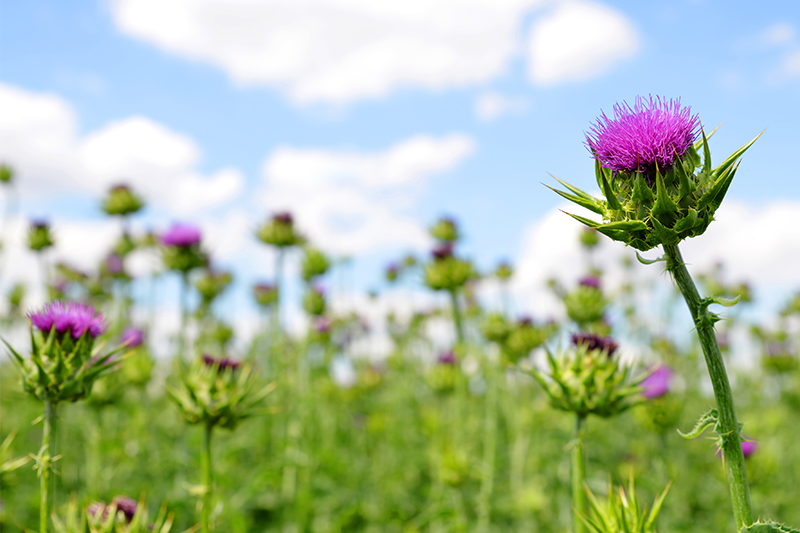Milk Thistle is native to the Mediterranean region of southern Europe, northern Africa and western Asia.3,4 The plant freely naturalizes and has been widely introduced to southern Canada, North and South America, Australia, China, Britain and Central Europe.2,5 It has even been classified as a noxious weed of varying levels in Arkansas, Oregon and Washington.2 It can regularly spread by self-seeding if the flowers are not removed after blooming.4
The preferred habitat is one of waste places or hedge banks that are likely near the ocean, especially when the soil is dry and rocky.3,6 It can be grown in all types of soils and pH, including very alkaline soil, but favors fertile, calcium carbonate-rich soil.3 Milk Thistle requires full sun, as it can’t tolerate shade, and well-drained soil.3 Milk Thistle can be used as green manure, as it creates substantial biomass when turned under the soil.3
Frost tolerant, it has its leaves year-round, flowering in the early summer and seeding in late summer to fall after pollination by bees.3,11
The common name, Milk Thistle, is based on the white “veins” on the leaf and the milky sap that is exuded from the leaves and stems.4,10 Similarly, the other common name of Mary’s Thistle, once called Our Lady’s Thistle, was a reference to the leaves’ milky white veins that were said to have originated from the Mary’s milk falling on the Thistle plant.6 The genus name Silybum comes from the Greek silybon, meaning “thistle-like plant.”4 Milk Thistle is often confused with the herb Blessed Thistle, as it was referred to with the same name and both herbs were used in folk herbalism to increase milk supply in lactation*. Blessed Thistle is now the official common name for a different but related plant, Centaurea benedicta syn. Cnicus benedictus.1 The leaves were called “Pig Leaves” as they are a delicacy of pigs, while the seeds are a favorite of goldfinches.6
In older times, all parts of the plant were consumed for food by humans.6 In the spring, people boiled and ate the flower heads, similar to Artichokes, as their diets were generally devoid of fresh vegetables over the winter.11 The root can be eaten raw and have a mild flavor with a mucilaginous texture.3 When the two year old roots are boiled, they are said to resemble Salsify.3,14 Prior to eating the leaves, the leaf spines must be removed.3 Young leaves have a mild flavor and can be used as salad greens or cooked as a substitute for cabbage or spinach, but beware as hot and dry weather may make the flavor bitter.3,9 To lessen the bitterness, young spring stems should be peeled and soaked in water first, then can also be added to salad or cooked similar to Asparagus, Sea Kale or Rhubarb.3,14 The young shoots, called khurfesh in Arabic, were harvested and consumed as a refreshing salad by Bedouin shepherds and others.15 In Charles Bryant’s 1783 book entitled Flora Diaetetica, the young shoots were also baked inside pies.6
When eating Milk Thistle, it is important that the plant is grown organically, as nitrates from chemical fertilizers have been known to concentrate in the leaves.3
The roasted seed can be used as a substitute for coffee, or when pressed raw, it releases a rich, fatty oil.3
Milk Thistle’s usage in herbalism dates back to the Roman naturalist, Pliny the Elder.6,10 Dioscorides, the Greek botanist, physician and pharmacologist, also used the seeds of the plant in herbalism.6
The aerial parts and root of the plant have also been used in western herbalism, though not ordinarily.9,12 In traditional Chinese medicine, the seed is used as a tincture or decoction and is said to have pungent, bitter, warm and dry qualities.13
Botanist, physician and astrologer of the 15th century, Nicholas Culpeper, ruled that generally thistles are under Jupiter’s dominion.6
Silymarin is thought to be the most active phytochemical that is called out on standardized Milk Thistle products. This compound is in fact, made up of a group of flavanolignans: the constituents silybin, silybinin, silychristin, silydianin silydristin, isosilybin, dihydrosilbin and others.12,13,16 Silymarin is highest in the fruit, but can also be found in the seeds and leaves.10
































